
Image: Simon Jönsson, Umeå universitet, Johanna Fredriksson

Image: Simon Jönsson, Umeå universitet, Johanna Fredriksson
FEATURE On Umeå Arts Campus, the Umeå School of Architecture, Umeå Institute of Design and Umeå Academy of Fine Arts form a creative triangle around Bildmuseet contemporary museum of art. And there, spring semester is coming to an end with a creative atmosphere awaiting graduation exhibitions. Ahead of the 2023 graduation, this reportage was created about students Frida Block, Isabelle Olsson and Jo Öqvist who were in the final stages of their work before graduating.
At the Umeå School of Architecture, lots is happening in all nooks and crannies of the building; some students are putting together some blocks of wood to form a wind shelter, presentations are held, and some students are working on some miniscule protypes.
Architecture student Frida Block, design student Isabelle Olsson and art student Jo Öqvist are all preparing for the graduation exhibitions that take place on the Art Campus at the end of May and beginning of June.
Frida Block is taking the Master's Programme in Architecture and Urban Design and has reached the very end of the programme before graduating in a couple of weeks. Her degree project is an analysis of Swedish housing standards. As a part of her project, she has studied blueprints of apartments granted building permits in Umeå in 2021. She took the standardised measurements, recalculated and produced new blueprints with similar apartments, but with a twist.
“There are clear standards for how to build apartments in Sweden both in terms of room size and interior design. Currently, apartments are designed based on standard measurements for stoves, wardrobes, wood length, standard-sized sofas, and so on. The measurements create the architecture just as much as the architecture create the measurements – they influence each other. But by breaking conventions, I think lots of exciting stuff could happen when it comes to accommodation,” says Frida Block.
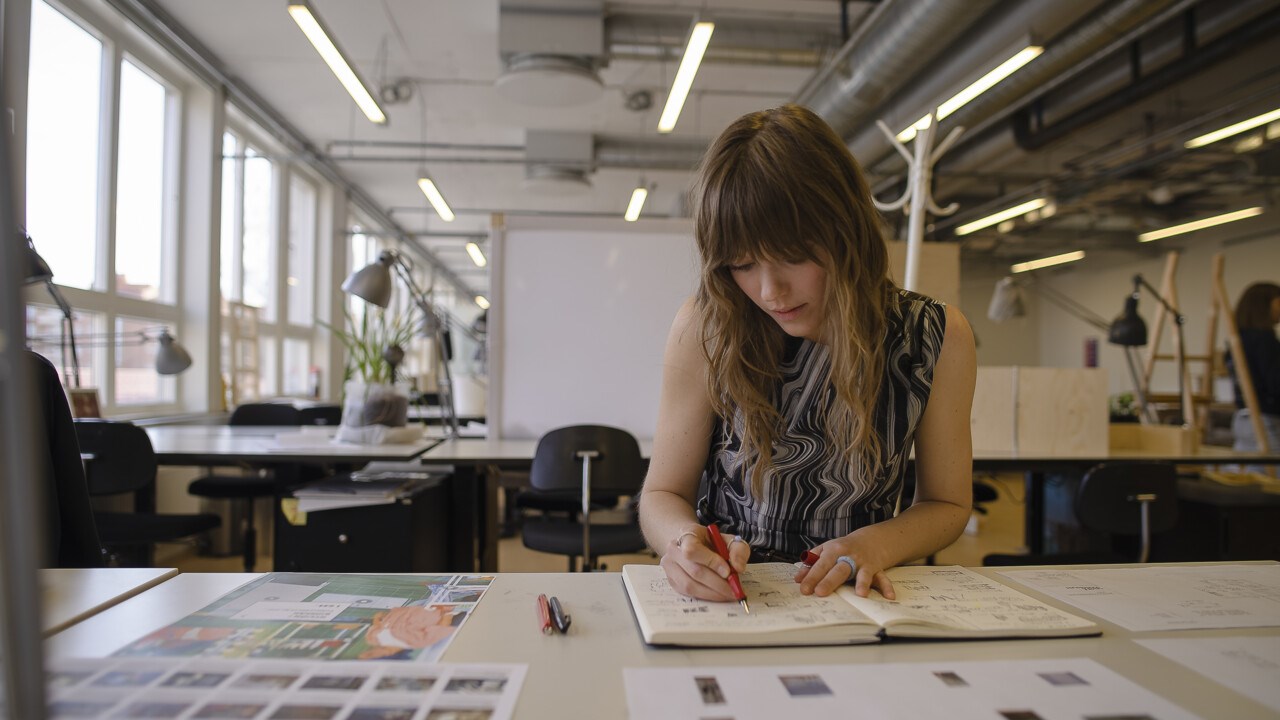
Frida Block studied for five years at Umeå school of Architecture, apart from a semester of exchange studies that she did in Prague. Soon she will take her master's degree: "It's hard to say what will happen now after graduation, but I'm thinking of looking for a job in Copenhagen in some office that feels fun. In the future, I would also be very interested in working within the School of Architecture, either in Umeå or elsewhere, because this climate is so incredibly cool to be a part of", she says.
ImageSimon Jönsson, Umeå universitet, Simon JönssonIn her degree project, she has built models of an apartment, so you can get a sense for the room and physically experience non-conventional standards and how it could contribute to a space. By showing something that you are used to – but adding small deviations – you open up for new ideas.
According to Frida Block, standardising accommodation limits human freedom as it standardised humans too. It creates a certain standardised individual based on the nuclear family as a template. These accommodations have one bedroom for a mum and dad, two bedrooms for their children and a set agenda for how to live in the Swedish accommodation.
“So much has happened over the last years and there are so many other ways to live. Ways that people have shown they want to live. I think architecture needs to adhere to that. Maybe architecture even needs to lead the way and show that new ways of living, other family formations or new living arrangements are possible. Also, accommodations do not make room for all types of interests these days as they all look the same,” she says emphasising that Swedes also spend a lot of time in their homes.
“This is our lives, which makes it really important.”
It’s been so developing – both in terms of how I perceive the world, but also my own self-reflection.
Frida Block has practically completed her degree project. In a few weeks, she will be leaving Umeå University and the Umeå School of Architecture after five years of studies.
“This has certainly been the most exciting full-time activity of my life. It’s been so developing – both in terms of how I perceive the world, but also my own self-reflection. I’ve learnt so much and the lecturers and their teaching have really been top notch.”
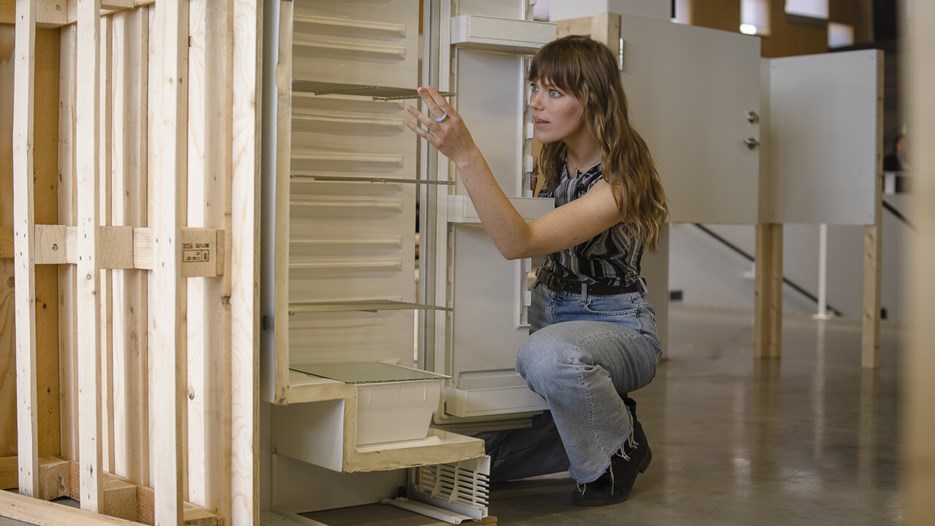
Frida Block has built her models based on Swedish standards, but with a twist. She has taken a normal-sized fridge and cut it into a smaller shape. “When you see something for the first time, you may see things in a new light. That’s why I cut the fridge, which also took a long time. But having a workshop at the institute fully equipped with tools is so much fun,” she says.
Image Simon Jönsson, Umeå universitet, Simon Jönsson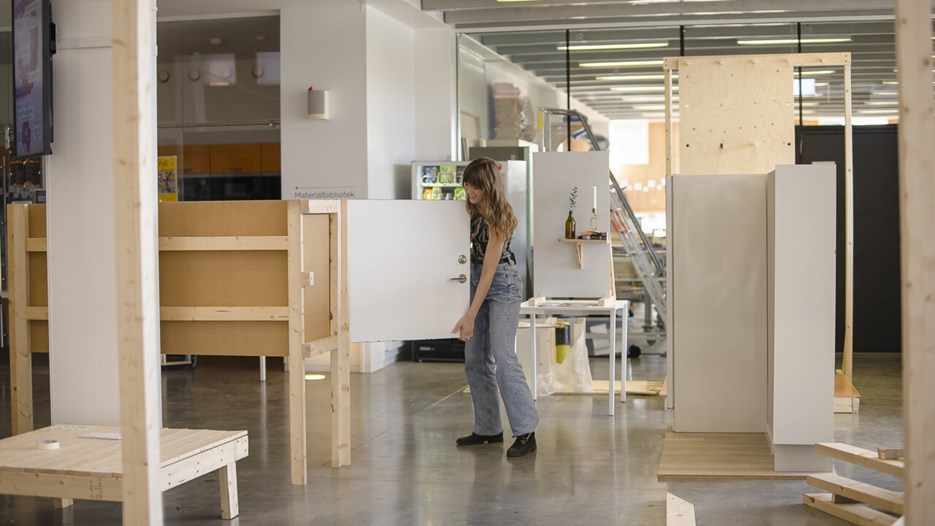
“I’ve also built a model of the space behind the bedroom door, where there usually isn’t any space. It looks so real since it has been built with a real Swedish door from an old student apartment. And when it looks real, we can start questioning what reality would feel like if it was different,” says Frida Block.
Image Simon Jönsson, Umeå universitet, Simon Jönsson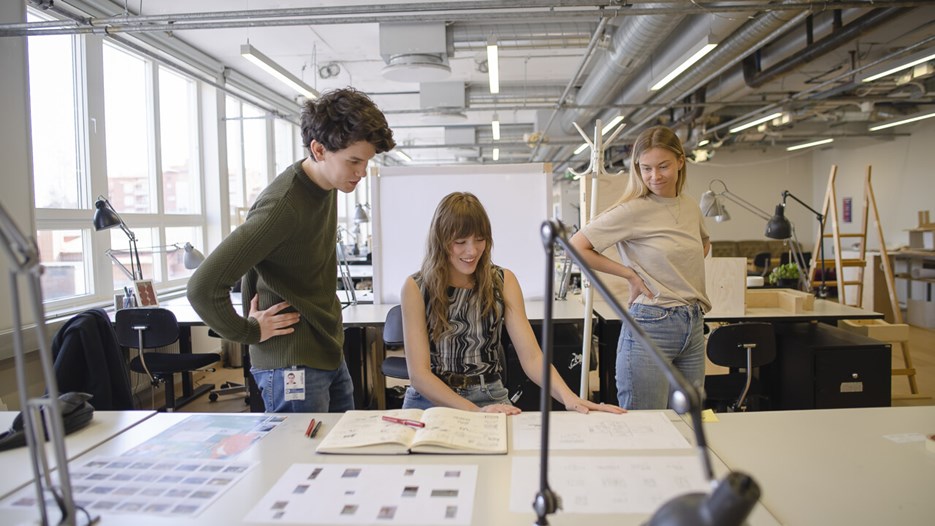
In her work, Frida Block has started from drawings of apartments that received building permission in Umeå in 2021, and changed them slightly. Here she shows them to architecture students Edvin Högberg and Emma Nordström.
Image Simon Jönsson, Umeå universitet, Simon JönssonStraight across the courtyard, a stone’s throw from the Umeå School of Architecture you will find the Umeå Institute of Design. Student Isabelle Olsson is stood facing her fellow students and teachers in the project studio, ready to present her degree project.
“Noise causes stress at a workplace. This could lead to long-term mental health issues for workers,” she starts her presentation by saying.
“So, this is my thesis: How can you allow people to screen off to improve psychosocial work environment in open-plan offices?”
Isabelle Olsson is taking the Bachelor’s Programme in Industrial Design at the Umeå Institute of Design. The degree project she is presenting in the project studio revolves around a silent office chair specially designed for open-plan offices. Through the use of sound-cancelling walls and a light-screening ceiling, the chair can create a zone with reduced audio and visual impressions without taking up too much room.
“One of the problems is that offices are often small these days, to be cost-effective. That means that many workers lack the possibility to use group rooms; or if there are such, they can often be fully booked. As a result, people can’t escape for some quiet time. Instead, they choose to work from home. That was something I wanted to tackle and improve. When I got into this project, I realised that people want to be at work. They appreciate the interactions they get at work,” she says whilst also showing how you can place your designer office chair in an open-plan office, which she has built a miniature of.
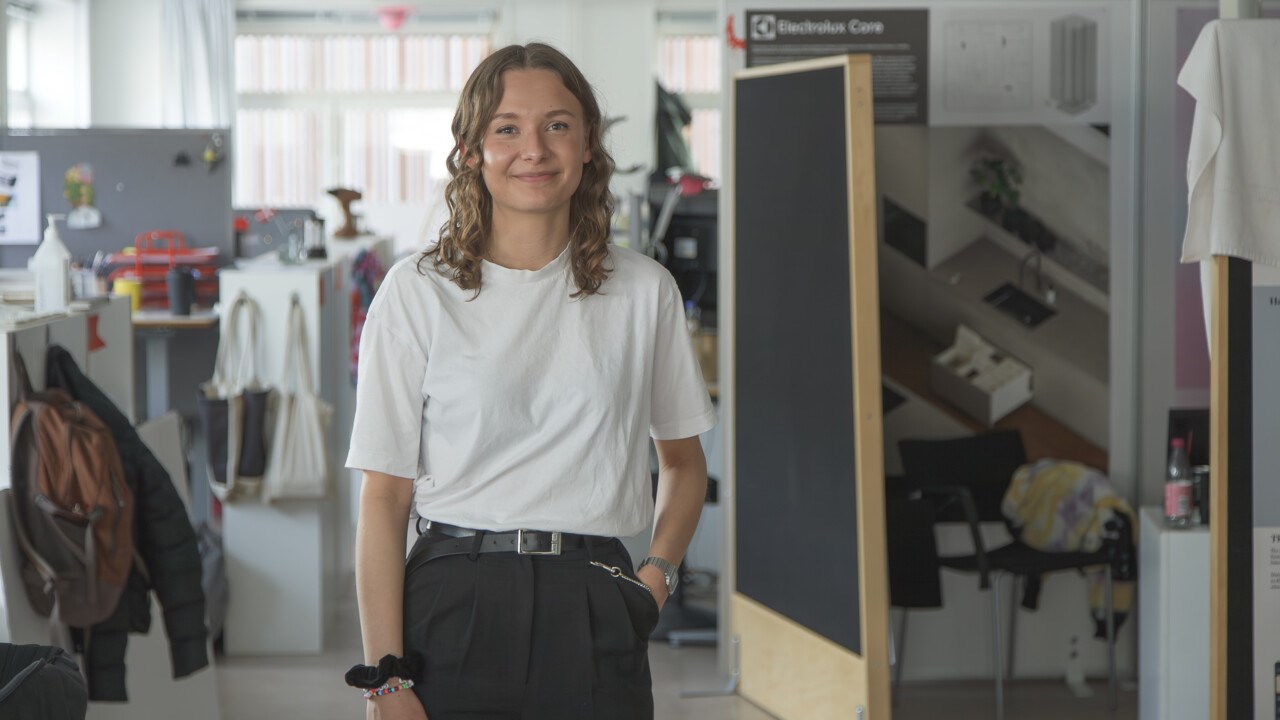
Isabelle Olsson will continue on the Master's programme after her Bachelor’s degree. Over the course of her first three years, she has really developed as a designer, she finds. “I can see massive progress when looking back at my old projects. And that’s not just in the sketches or use of CAD, but also how I approach things. It’s been very developing,” she says.
ImageSimon JönssonThrough the project, she has collaborated with a company producing office furniture.
“They are talking about building the chair. They are setting up a supply chain to potentially put it on the market,” she says.
Isabelle Olsson took her upper-secondary studies in Gothenburg and did her workplace training at the design office of Volvo when a former student of Umeå Institute of Design recommended her to apply to the industrial design programme in Umeå.
“The application deadline was only a few weeks away. I didn’t even know industrial design was something you could study. But I applied and was admitted, which I’m so glad I did. It’s an amazing atmosphere and a creative programme in a creative environment,” she says.
Really and truly, everything needs to be designed so you can just take your pick at a specialisation.
In a few weeks, she will be graduating but she is not planning on leaving the institute. This autumn, she will start the Master’s Programme in Advanced Product Design.
“What’s best about taking industrial design is that what you can do is endless. Really and truly, everything needs to be designed so you can just take your pick at a specialisation,” she says.
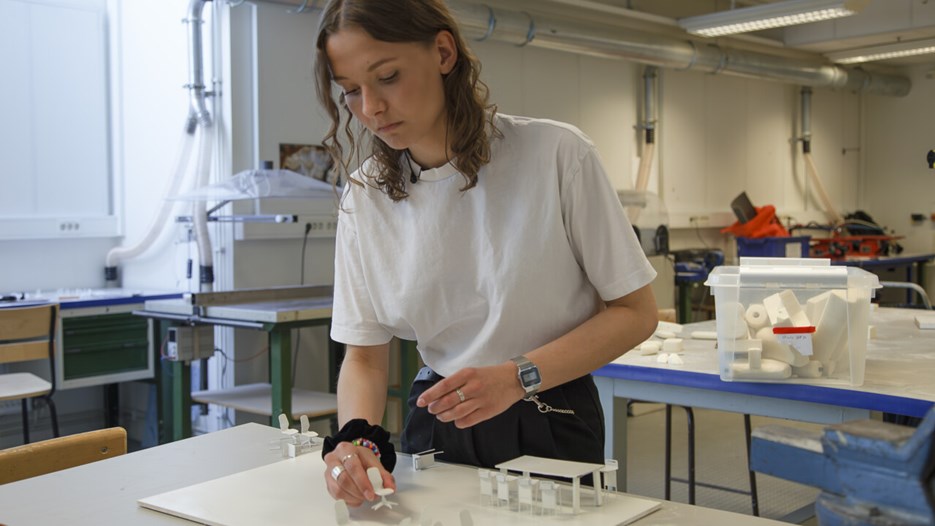
In her degree project, Isabelle Olsson has built a miniature office landscape in the Umeå Institute of Design workshop to visualise her chair and its functionality.
Image Simon Jönsson, Umeå universitet, Isak Lövgren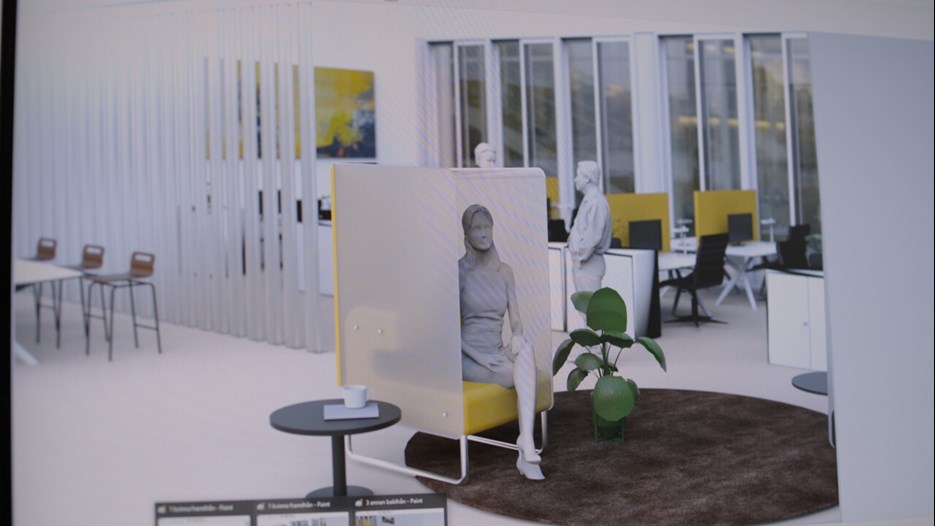
The chair is meant to be placed where it suits you best in an open-plan office. The back wall is noise cancelling, the ceiling light reducing and the walls are frosted to reduce visual distractions. In that way, the chair creates a calm atmosphere in a big room. “I’ve worked in several open-plan offices and have been disturbed by those issues. Hence, this is a problem I wanted to take on,” says Isabelle Olsson.
Image Simon Jönsson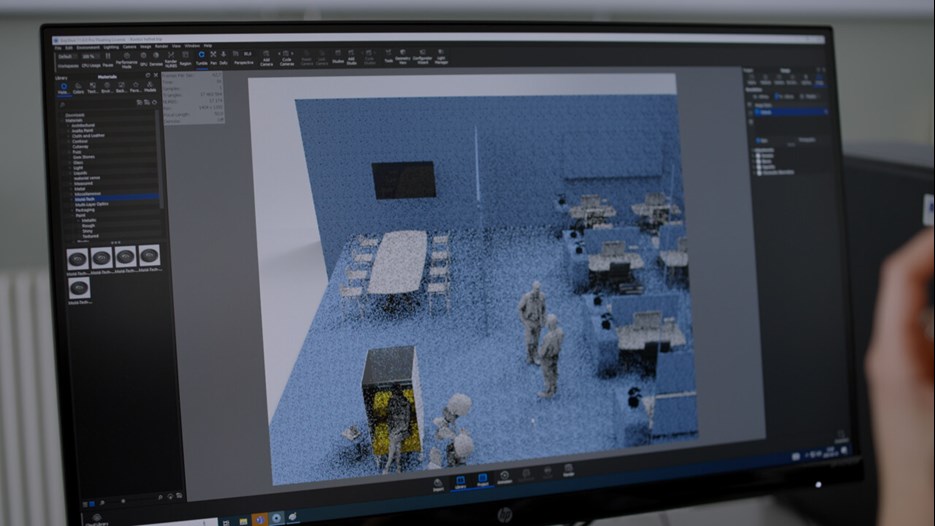
On a level below the design students’ studio, you can find a door leading directly into Bildmuseet. In the exhibition hall on level three, art students Jo Öqvist and Emie (whose real name is Eva-Marie Elg) are preparing their graduation exhibitions.
Umeå Academy of Fine Arts, at which they are both studying, is actually just around the corner, but Master’s students are welcome to exhibit their graduation projcts in the halls of the well-reputed Bildmuseet. The museum, by the way, is reopening on 26 May with several new art exhibitions, one of which is that of the Master’s students. A novelty for this year is that the exhibition will be open all summer – not just for a few weeks.
“It feels exciting to exhibit our works at this amazing museum. It’s slightly nervous and scary, but it’s such a great opportunity. And Bildmuseet has been great to work with,” says Jo Öqvist.
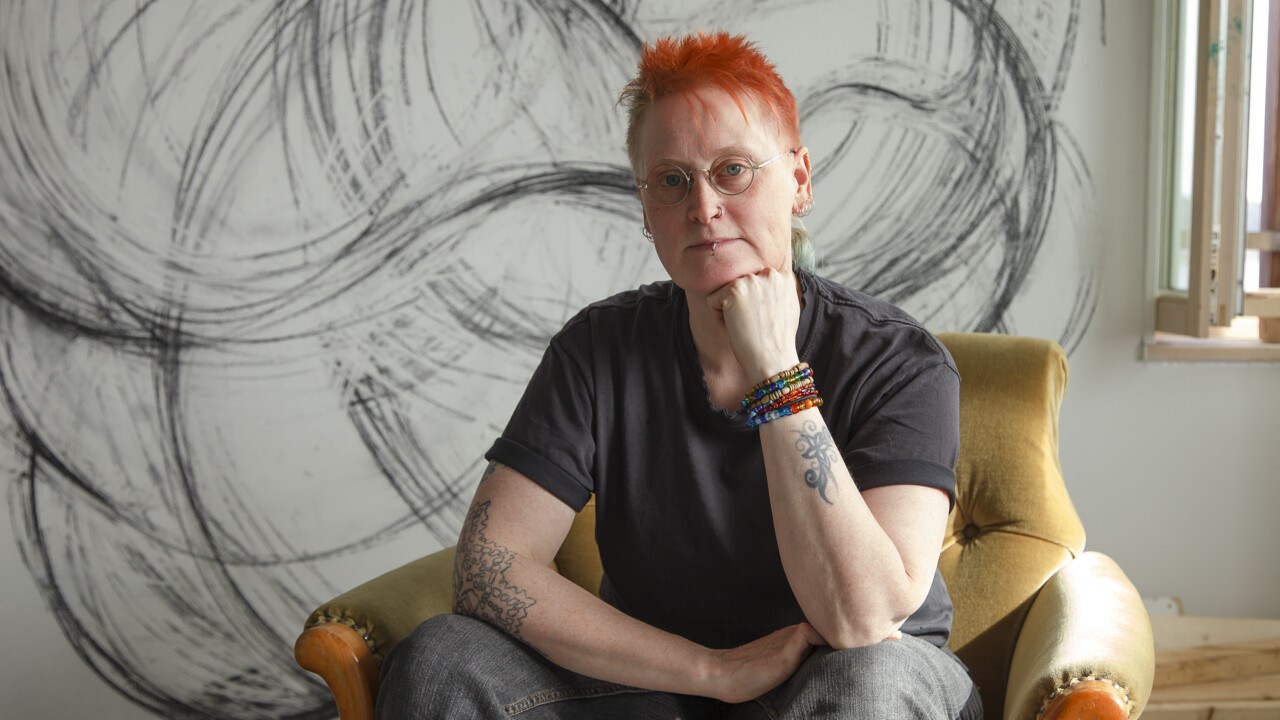
Jo Öqvist has worked with bodies and human figures throughout the career as an artist. "That's what I'm drawn to, what interests me and where my focus ends up all the time".
ImageSimon Jönsson, Umeå universitet, Johanna FredrikssonThroughout Jo Öqvist's artistry, bodies and the human shape have been of huge interest. Jo Öqvist graduated with a Bachelor’s degree from HDK-Valand – Academy of Art and Design at the University of Gothenburg with a specialisation in ceramics. With time, Jo Öqvist wanted to do more drawing and applied to the Umeå Academy of Fine Arts to take a Master's programme.
Being a human in a body is simultaneously dynamic and troublesome. That’s the message I wish to convey.
In the included degree project, Jo Öqvist has chosen to work with charcoal on a large scale and directly on the wall of Bildmuseet.
“I want to express myself by creating something huge and relating to our own bodies. Bodies manifesting ambivalence, a reagent. About bodies attracting and repelling each other. Being a human in a body is simultaneously dynamic and troublesome. That’s the message I wish to convey.”
And working with charcoal has been important in that process.
“Charcoal is an outstanding material. I draw some and then erase just as much. That creates the image. When I start drawing, I will inevitably make mistakes. I use those mistakes to create movement,” says Jo Öqvist whilst approaching the mural making large arm gestures to show how the entire arm’s length is used in the creative process.
“When erasing the initial sketches, a vibration or movement is created in the drawing. That’s how I make use of my own mistakes.”
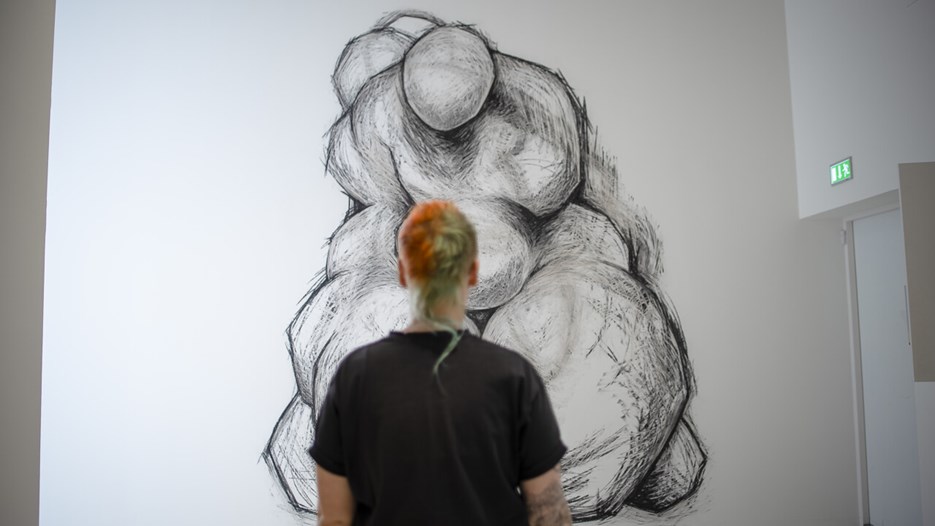
For the degree exhibition, Jo Öqvist has made a charcoal mural on the Bildmuseet wall on level three. “I’ve long wanted to upscale my projects,” says Jo Öqvist.
Image Simon Jönsson, Umeå universitet, Simon Jönsson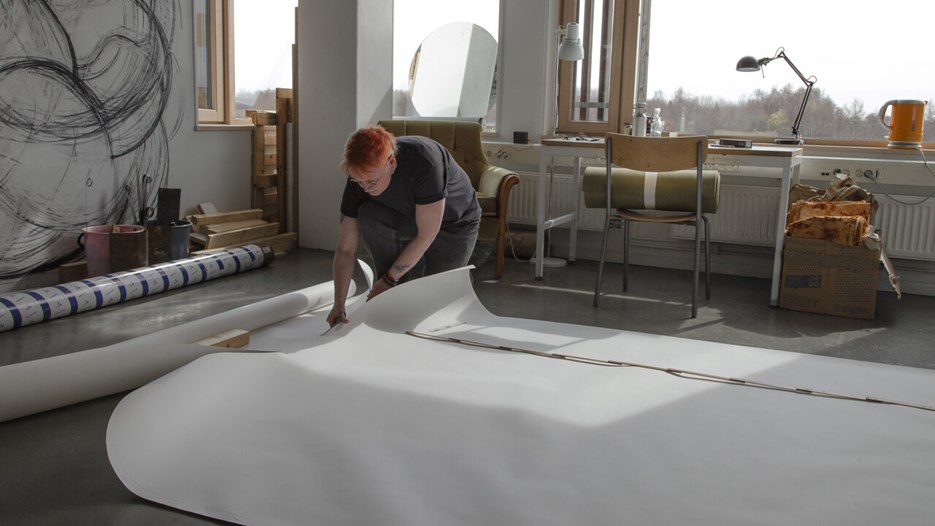
Jo Öqvist has a studio in a vast corner room of the Umeå Academy of Fine Arts with magnificent views over the Ume River. Working in this room is something Jo Öqvist will sorely miss after graduating.
Image Simon Jönsson, Umeå universitet, Johanna Fredriksson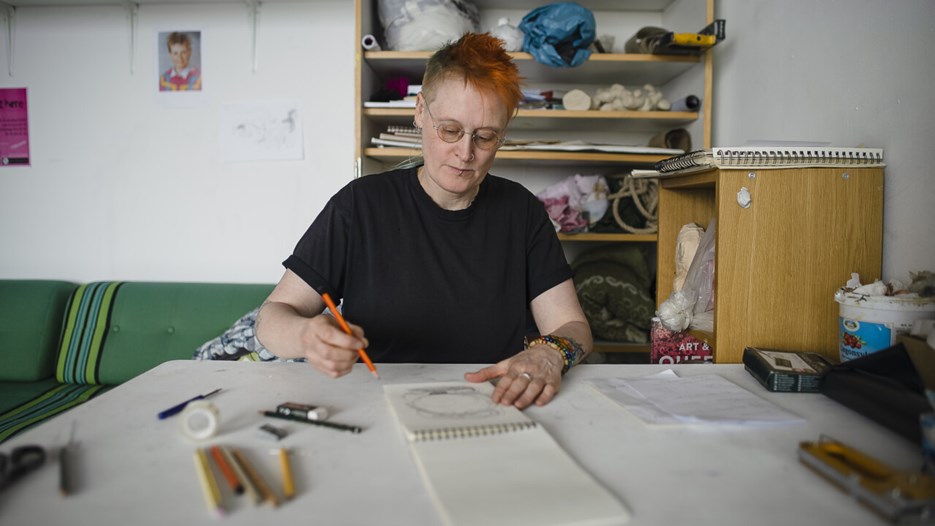
“After graduating, I will work as an artist. But I will also have other gigs on the side, which most artists have and need to have. But I think it will all work out,” says Jo Öqvist.
Image Simon Jönsson, Umeå universitet, Simon JönssonAs a contrast to the black charcoal mural on a white background in a bright room, Emie is working on a video installation that she is presenting in a dark room built in the middle of the room in the art exhibition. Beside these two exhibitions, another ten Master’s students from the Umeå Academy of Fine Arts will exhibit their work on level three and four of Bildmuseet.
“I always find group exhibitions really interesting as they offer so many different expressions. Something may feel more appealing, but other parts may challenge you to see things you probably wouldn’t have chosen to see otherwise,” says Jo Öqvist.
In contract to designer student Isabelle Olsson’s background, Jo Öqvist has had a long and winding path to education. Already as a 22-year-old, Jo Öqvist took a preparatory education with higher education studies in sight. But nearly 20 years elapsed until that dream came true.
“My path to the Umeå Academy of Fine Arts has been rather windy. I took a preparatory art education already in 1999 as I knew I wanted to pursue higher education. But it was difficult to get admitted as the number of applicants was high. So, for a long time, I thought I needed to rethink. I studied music at a folk high school, worked and did other things. It took a fair few years, but all the time I knew art was what I really wanted to do,” says Jo Öqvist.
“I’m now 45 years old and am taking my last higher education semester. Although I had a long way to come, I also think it’s good to find your own path in life rather than just make a choice about a profession early in life. That route has a lot of advantages, but naturally also poses a lot of challenges. I’m incredibly glad I’m here now.”
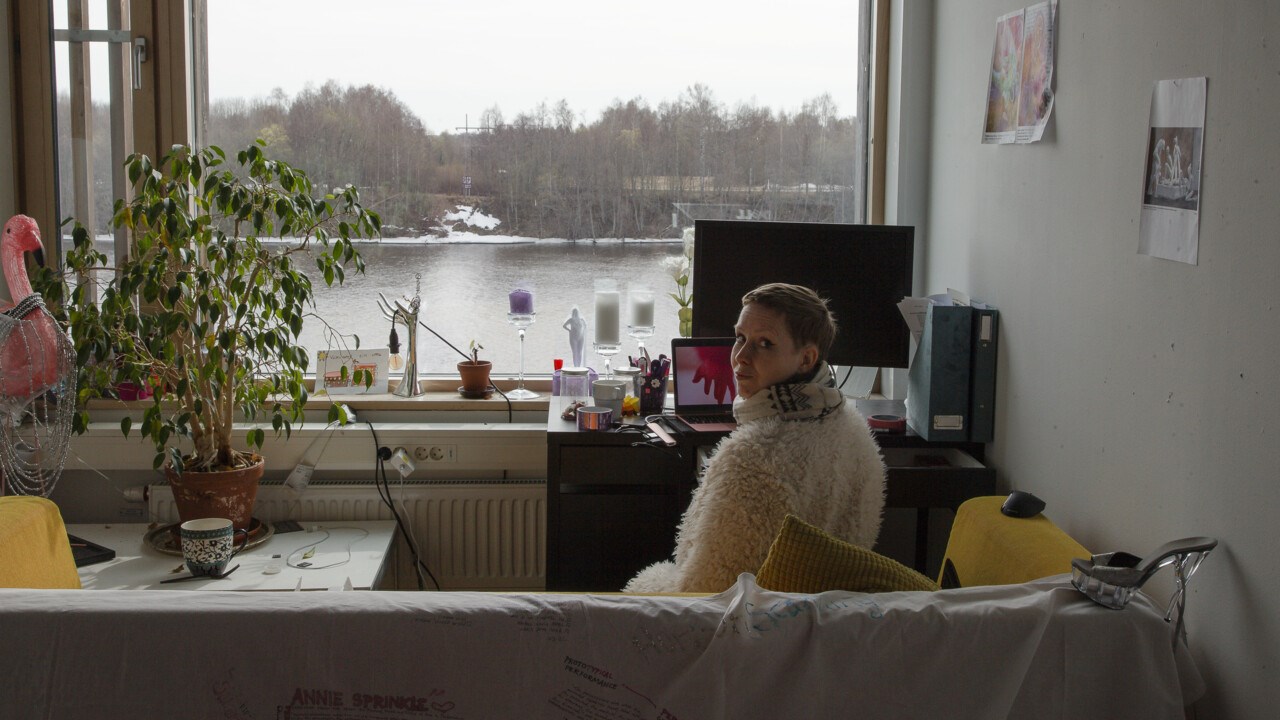
Student Emie is also taking her Master’s degree this spring. In contrast to Jo’s drawing using natural materials such as charcoal, Emie is working with digital art and video installations.
ImageJohanna FredrikssonJo Öqvist’s studio at the Umeå Academy of Fine Arts is placed in a corner with fabulous views in two directions over the Ume River. This room is one of the things Jo Öqvist will really miss after graduating, but also all the people, of course.
“This programme has really meant a lot and has made a lasting impression on me. Not least all the active artists I have met through the education. That has been most important to me. And my fellow students of course, as well as other students at the academy. And all the meetings and learning from each other too.”
The degree exhibition week at Umeå Arts Campus starts on Friday, 26 May when both the Umeå School of Architecture and the Umeå Academy of Fine Arts open their degree exhibitions. On the same day, Bildmuseet reopens with Art Friday after some time of renovations. Umeå Institute of Design opens its degree exhibitions on 3 June.
Read more about all exciting exhibitions and events at Umeå Arts Campus 2024.